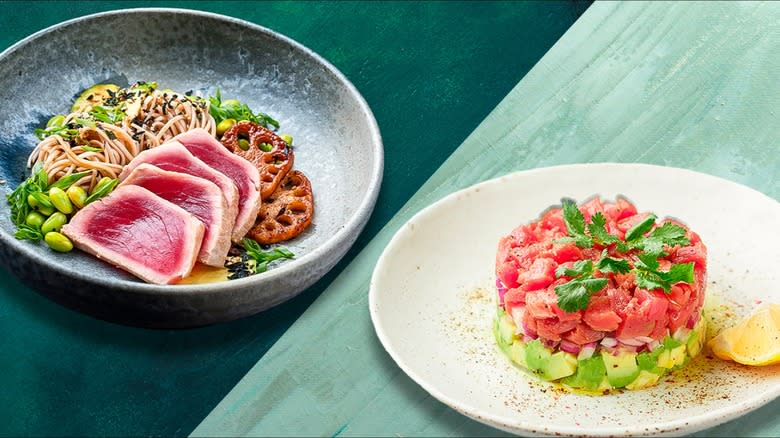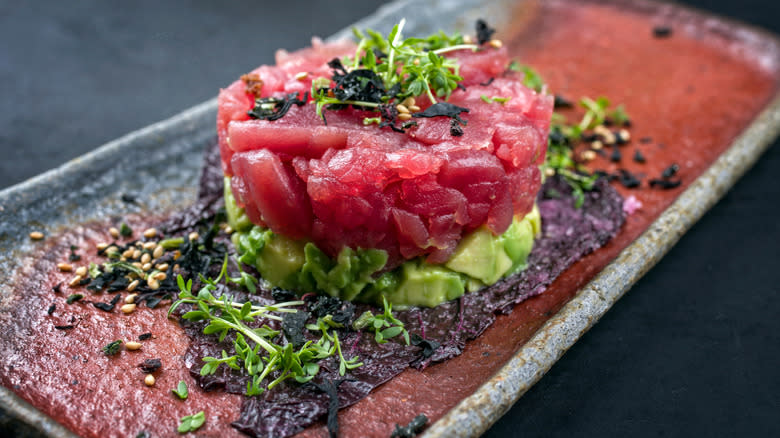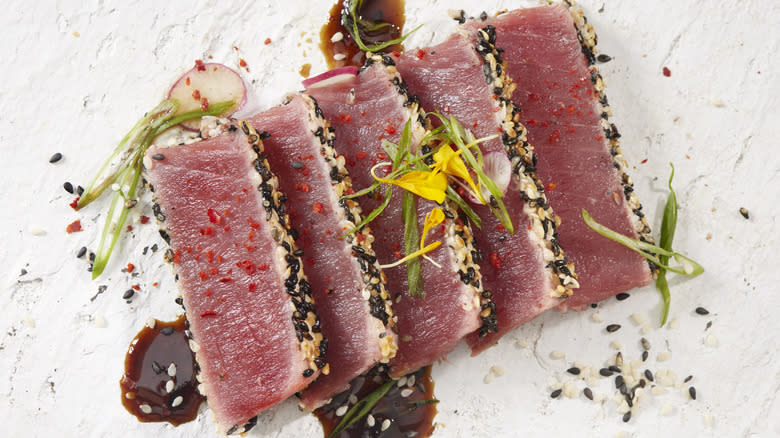What's The Difference Between Tuna Tataki And Tartare?

When the mood strikes and you're fiending for some raw tuna, the canned stuff (even the best brands) isn't going to cut it. For tuna tataki and tuna tartare, only fresh, sashimi-grade tuna steaks will get the job done. Both dishes are on the menu at the globally famous Nobu sushi restaurant in downtown New York (they're that good). Or, if you're feeling ambitious, you could totally buy the whole fish and filet it yourself (if you go this route, Chef Thomas Keller has a few tips for the road) or visit your local fishmonger and ask the experts behind the counter to cut off a few filets for you to satisfy your craving.
Still, whether you're sitting down for a fancy meal out or carving up an ahi tuna filet yourself at home, raw fish fans might be wondering: What's the difference between tuna tataki and tartare? The two main factors that separate these tuna steak recipes are that tataki is pan-seared and sliced into larger strips, while tartare is raw and cut into a mince -- factors that also determine how these two dishes are served.
Read more: 15 Different Ways To Cook Fish
What Is Tuna Tataki?

Tuna tataki is a Japanese dish made from lightly-seared tuna filets. Yellowfin or ahi tuna steak is quickly pan-fried in oil in a heavy-bottomed skillet for golden browned savory outsides and a buttery, raw center on each filet, then sliced into ¼-inch thick strips. Commercially flash-frozen tuna steaks can also work for this one since it's getting seared around the edges, but be sure you're getting a high-quality, sushi-grade cut that you can safely ingest raw.
The tuna steaks can be seared in neutral vegetable oil to let the fish's flavor shine, or they can be fried in peanut oil for a bolder profile. After searing and slicing, tuna tataki is often dressed in tangy rice vinegar and garnished with umami-forward bonito flakes, pickled red onions, chopped chives, and Asian shiso leaves (an herb that tastes like cilantro mixed with basil). In Japan, tataki (たたき) is commonly served with citrusy soy sauce, shiso, and grated ginger, garlic, and daikon.
What Is Tuna Tartare?

Tuna tartare (not to be confused with crudo, which is marinated in citrus juice) is made from finely minced, sashimi-grade raw tuna. Those mini cubes are cut into a ¼-inch dice and tossed in flavorful spices and/or oils, ranging from a simpler dressing of salt, vinegar, and olive oil to bolder preparations like lime juice, wasabi, and soy sauce. Minced fresh veggies are thrown into the dice for added body as well, commonly red bell pepper, shallots, chopped parsley, boiled potato, avocados, onions, or cabbage. To combine, the tuna and vegetable dice are stirred together with a binding agent, often mayonnaise.
With tuna tartare, it's all about the natural flavor of fresh, high-quality tuna and the plush texture of the fine mince. The filets are sliced along the natural grain lines into thin strips, then sliced again into cubes. If you're making it at home, allow the mixture to sit in the fridge for at least one hour before serving so all the flavors have a chance to meld together into a profile greater than the sum of its parts. If you're using avocado, keep in mind that it will likely discolor your tartare if you stick it back in the fridge. To help those avocados retain their bright green hue, add them to the tartare immediately before serving.
Tuna Tataki Is Seared And Sliced Into Toothy Slabs

Unlike tuna tartare, which is served raw, a defining aspect of tuna tataki is the golden pan-sear around the edges of each filet. This preparation, as well as the size of the pieces, means that tuna tataki is served differently from the fine-minced tartare. In short, tataki is more of a plated substantial snack or meal, while tartare is an appetizer through and through.
Tuna tataki can be crusted in black and white sesame seeds for a crunchy textural component, which makes a great lunch paired with fresh avocado salad or this Spicy Korean Cucumber Salad with gochugaru. The pieces can be dipped in sauces like ginger vinaigrette or Japanese ponzu sauce or served over a bed of fresh greens for an elevated, protein-packed salad. Or, use your tataki to top a protein-packed tuna poke bowl.
You could serve those toothy strips of tuna tataki as an hors d'oeuvre at a dinner party. For an impressive, upscale first-course plating, garnish your tuna tataki with a few crimson Korean chili threads. Or, arrange your seared tuna tataki pieces in a circular fanning shape around a plate, nestled on top of an aromatic Asian perilla leaf, with a smear of spicy ginger sauce across the bottom of the plate. A crisp lettuce leaf works here, too.
Tuna Tartare Is Raw And Spreadable

Unlike the meaty bite-sized chunks of tuna tataki, tuna tartare is spreadable. It's typically served one of three ways: in a large bowl with a spoon for foodies to serve themselves; spread onto crackers; or shaped and plated. If you're into the molding camp, we're all about these tuna tartare stacks with wasabi shishito peppers. To many fans, tuna tartare is all about the interplay of the crunchy vehicle with the soft, tender tartare, which is why it's commonly served on crackers, chips, toasted crostini, or fried wonton strips.
Tuna tartare started accruing a fanbase during the 1980s, riding on the coattails of the popular French steak tartare. Per the lore, its invention is credited to Japanese chef Shigefumi Tachibe, who allegedly created tuna tartare in 1984 while working at Chaya Brasserie in Beverly Hills. For the new, unfamiliar audience, raw ahi tuna might have seemed more approachable than raw beef. Borrowing from its beefy inspiration, the mayo-bound tuna tartare is often shaped using a pastry ring into a clean cylindrical puck to plate. Steak tartare is often served with a single quail egg on top; this is less common for serving tuna tartare, which is usually garnished with fresh avocado and parsley.
Read the original article on Tasting Table


